Sword 1/72 Grumman
G-21A Goose
|
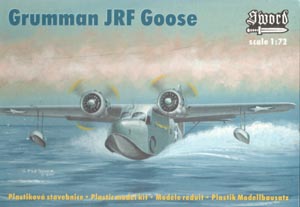 |
History
For a potted history of the beginnings of
Grumman please see the History portion of my FIRST LOOK review
of Classic Airframes' Grumman Duck in the July 2001 issue of Internet
Modeler. The Goose amphibian was Grumman's second design to go into series
production. It was also their first monoplane, their first twin engined
plane and their first plane designed for the civil market. The G-21 made
its first flight on May 29, 1937. The two Pratt & Whitney R-985 engines
gave the Goose a cruise speed of 150 to 175 mph. Normal fuel tankage provided
a range of up to 800 miles carrying four to six passengers, plus baggage,
and a crew of two. The first Goose was delivered to Marshall Field on
September 29, 1937.
The first dozen were designated G-21; the remainder of the 30 civilian
Gooses were designated G-21A as they had minor changes from the basic
design. All the military Gooses were based on the G-21A configuration
and had variations as required by their intended military use. Military
designations for the Goose were:
USAAC/USAAF:
|
OA-9 A and 0A-13A & B
|
USN/USMC & USCG:
|
JRF-1 through 6, plus letter suffixes
|
UK:
|
GOOSE I & IA
|
Other nations used one of the US
designations depending upon the configuration details of the specific
model acquired.
Although designed as a light amphibian transport
for private civil use, only the first 30 Gooses went to private buyers.
The remainder of the 1,345 total built went to various military operators
including: US Army, US Navy, US Coast Guard, USMC, Argentina, Bolivia,
Brazil, Canada, France, Paraguay, Peru, Portugal and the UK. Post WWII,
Gooses served with military, government and civilian operators in many
more countries. Today the Goose is a very desirable antique airplane
of great practical value and I'd sure like to be able to afford to have
one moored out in front of my house.
Please note, amongst the cognoscenti, the
plural for the Goose is always "Gooses" - never "Geese".
The Kit
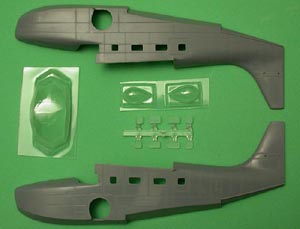 Being
a Czech kit, it comes in one of their standard, patented, flimsy, end-opening
boxes that is guaranteed to collapse if other kits are stacked atop it.
Inside are 63 parts cleanly injection molded in medium gray styrene, 13
parts well cast in resin of the same color, eight side windows injection
molded in clear styrene, two vac-formed, bulged side windows and two vac-formed
windscreens. The quality of kits from Sword and all the other Czech manufacturers
keeps getting better and better and this kit continues that progression
with one significant design hiccup. Sword did a very good job of modeling
the subtle catenary sag of fabric between the wing ribs but the ribs under
the fabric covered areas of the wing and tail are represented by scribed
lines - shades of the Hawk kits of the 1940's! If you are an anal retentive,
nit-picking AMSer like me, this fact will send you into paroxysms of anguish
for there are 222 individually scribed "rib" lines of various
lengths to be filled, filed and converted to rib-tape simulations by application
of narrow strips of decal stock! Other than that, Mrs. Lincoln, the moldings
are flawless. Being
a Czech kit, it comes in one of their standard, patented, flimsy, end-opening
boxes that is guaranteed to collapse if other kits are stacked atop it.
Inside are 63 parts cleanly injection molded in medium gray styrene, 13
parts well cast in resin of the same color, eight side windows injection
molded in clear styrene, two vac-formed, bulged side windows and two vac-formed
windscreens. The quality of kits from Sword and all the other Czech manufacturers
keeps getting better and better and this kit continues that progression
with one significant design hiccup. Sword did a very good job of modeling
the subtle catenary sag of fabric between the wing ribs but the ribs under
the fabric covered areas of the wing and tail are represented by scribed
lines - shades of the Hawk kits of the 1940's! If you are an anal retentive,
nit-picking AMSer like me, this fact will send you into paroxysms of anguish
for there are 222 individually scribed "rib" lines of various
lengths to be filled, filed and converted to rib-tape simulations by application
of narrow strips of decal stock! Other than that, Mrs. Lincoln, the moldings
are flawless.
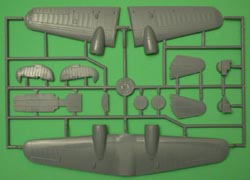 Fourteen
very well illustrated construction steps, a parts map, a brief history
of the type by Chris Hughes and a colors and markings guide for three
different color schemes are all included in the well printed and easily
understood 12 page instruction pamphlet. The colorful, small, decal sheet
by Techmod is sharply printed in perfect register and provides three color
schemes. One is for an RAF Goose IA in temperate seaplane camouflage.
The second is for a JRF-6A of the French Aeronavalé in overall sea blue
gloss. The third scheme is for JRF-5, US Navy Bureau of Aeronautics No.
37828 as restored by John Pletcher of Anchorage,
Alaska in 1994-5 and given the civil
registration N703. Fourteen
very well illustrated construction steps, a parts map, a brief history
of the type by Chris Hughes and a colors and markings guide for three
different color schemes are all included in the well printed and easily
understood 12 page instruction pamphlet. The colorful, small, decal sheet
by Techmod is sharply printed in perfect register and provides three color
schemes. One is for an RAF Goose IA in temperate seaplane camouflage.
The second is for a JRF-6A of the French Aeronavalé in overall sea blue
gloss. The third scheme is for JRF-5, US Navy Bureau of Aeronautics No.
37828 as restored by John Pletcher of Anchorage,
Alaska in 1994-5 and given the civil
registration N703.
The physical configuration of the kit is
based upon the restored, and modified, N703 as it is today with some exceptions.
This fact compromises the accuracy of all three airplanes covered by the
decal sheet. These are the problems:
-
Only the pre-war G-21s had a window
in the main entry door on the left side of the airplane. The kit has
this window because Mr. Pletcher added it whilst restoring N703.
-
The G-21s originally had no spray suppression
skirts on the forward chine. Short side skirts were incorporated
on the G-21As and generally retrofitted to the G-21s. Post war, most
Gooses were retrofitted with the wide wrap-around spray suppression
skirt included in the kit.
-
All Gooses were built with two-bladed
Hamilton-Standard constant speed propellers, which are the only propellers
included in the kit. N703 was, however, given three bladed props
and large sharp pointed spinners that enclose the blade roots during
its restoration.
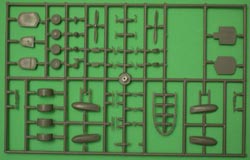 So,
here's what you've got to do if you choose to model one of the color schemes
given on the decal sheet: So,
here's what you've got to do if you choose to model one of the color schemes
given on the decal sheet:
RAF & Aeronavalé: Fill the window in
the door and cut off the front of the spray suppression skirt back to
the first vertical panel line on the fuselage and slim down the width
of the remaining skirt a bit.
N703: Find a pair of 7' 10" three-blade
square tipped constant speed propellers. make radar transponder antennae
for either side of the fin. Make a small GPSS disc antenna for atop the
fuselage and make two VHF antennae for atop the wing. Make vac-formed
bulged side windows for the cockpit. No; you can't use the kit's vac-formed
bulged windows as they are sized to go over the second side window in
the passenger cabin of the RAF plane and are too small for the cockpit.
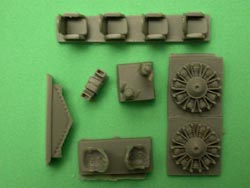 Am
I being too much of a nit-picker on accuracy? I don't think so; you might.
To each his own. Always do your own research. Pick a subject that you
can document to your satisfaction and enjoy the project. The small, low
budget, Czech kit manufacturers are at a big disadvantage in that they
can't afford to go out and find a survivor of every chosen subject or
take the time to access all the extant reference materials and must rely
on others for their data and have no real means of verifying much of it.
I have just provided information on a soon to be released British subject
and it is with great trepidation that I anticipate seeing how the resulting
kit looks. You'll read about it here. Am
I being too much of a nit-picker on accuracy? I don't think so; you might.
To each his own. Always do your own research. Pick a subject that you
can document to your satisfaction and enjoy the project. The small, low
budget, Czech kit manufacturers are at a big disadvantage in that they
can't afford to go out and find a survivor of every chosen subject or
take the time to access all the extant reference materials and must rely
on others for their data and have no real means of verifying much of it.
I have just provided information on a soon to be released British subject
and it is with great trepidation that I anticipate seeing how the resulting
kit looks. You'll read about it here.
Conclusion
My nit-picking not withstanding, this is
a very good kit, which will go together easily and make a good looking
model straight out-of-the-box. Congratulations to Sword for another subject
that has been ignored by the big name manufacturers of kits in 1/72 scale.
References
Warplanes of the Second World War, Volume
Five-Flying Boats: William Green, Doubleday,
New York 1962.
Sport Aviation (monthly journal of the EAA)
for August 1998. Budd Davisson article on N703 - Great photos.
https://www.airliners.net/open.file?id=185564
- The photo upon which the kit box-art is obviously based. This site
also has several other Goose photos.
Wings Magazine for August 1994: Article
titled "Grumman Seabirds" by Jack Dean.
Skyways - Journal of the Airplane 1920-1940,
Nos. 7, 15 and 34.
Many magazine and personal photos from the
files of aviation artist John Amendola.
|








|

 Being
a Czech kit, it comes in one of their standard, patented, flimsy, end-opening
boxes that is guaranteed to collapse if other kits are stacked atop it.
Inside are 63 parts cleanly injection molded in medium gray styrene, 13
parts well cast in resin of the same color, eight side windows injection
molded in clear styrene, two vac-formed, bulged side windows and two vac-formed
windscreens. The quality of kits from Sword and all the other Czech manufacturers
keeps getting better and better and this kit continues that progression
with one significant design hiccup. Sword did a very good job of modeling
the subtle catenary sag of fabric between the wing ribs but the ribs under
the fabric covered areas of the wing and tail are represented by scribed
lines - shades of the Hawk kits of the 1940's! If you are an anal retentive,
nit-picking AMSer like me, this fact will send you into paroxysms of anguish
for there are 222 individually scribed "rib" lines of various
lengths to be filled, filed and converted to rib-tape simulations by application
of narrow strips of decal stock! Other than that, Mrs. Lincoln, the moldings
are flawless.
Being
a Czech kit, it comes in one of their standard, patented, flimsy, end-opening
boxes that is guaranteed to collapse if other kits are stacked atop it.
Inside are 63 parts cleanly injection molded in medium gray styrene, 13
parts well cast in resin of the same color, eight side windows injection
molded in clear styrene, two vac-formed, bulged side windows and two vac-formed
windscreens. The quality of kits from Sword and all the other Czech manufacturers
keeps getting better and better and this kit continues that progression
with one significant design hiccup. Sword did a very good job of modeling
the subtle catenary sag of fabric between the wing ribs but the ribs under
the fabric covered areas of the wing and tail are represented by scribed
lines - shades of the Hawk kits of the 1940's! If you are an anal retentive,
nit-picking AMSer like me, this fact will send you into paroxysms of anguish
for there are 222 individually scribed "rib" lines of various
lengths to be filled, filed and converted to rib-tape simulations by application
of narrow strips of decal stock! Other than that, Mrs. Lincoln, the moldings
are flawless. Fourteen
very well illustrated construction steps, a parts map, a brief history
of the type by Chris Hughes and a colors and markings guide for three
different color schemes are all included in the well printed and easily
understood 12 page instruction pamphlet. The colorful, small, decal sheet
by Techmod is sharply printed in perfect register and provides three color
schemes. One is for an RAF Goose IA in temperate seaplane camouflage.
The second is for a JRF-6A of the French Aeronavalé in overall sea blue
gloss. The third scheme is for JRF-5, US Navy Bureau of Aeronautics No.
37828 as restored by John Pletcher of
Fourteen
very well illustrated construction steps, a parts map, a brief history
of the type by Chris Hughes and a colors and markings guide for three
different color schemes are all included in the well printed and easily
understood 12 page instruction pamphlet. The colorful, small, decal sheet
by Techmod is sharply printed in perfect register and provides three color
schemes. One is for an RAF Goose IA in temperate seaplane camouflage.
The second is for a JRF-6A of the French Aeronavalé in overall sea blue
gloss. The third scheme is for JRF-5, US Navy Bureau of Aeronautics No.
37828 as restored by John Pletcher of  So,
here's what you've got to do if you choose to model one of the color schemes
given on the decal sheet:
So,
here's what you've got to do if you choose to model one of the color schemes
given on the decal sheet: Am
I being too much of a nit-picker on accuracy? I don't think so; you might.
To each his own. Always do your own research. Pick a subject that you
can document to your satisfaction and enjoy the project. The small, low
budget, Czech kit manufacturers are at a big disadvantage in that they
can't afford to go out and find a survivor of every chosen subject or
take the time to access all the extant reference materials and must rely
on others for their data and have no real means of verifying much of it.
I have just provided information on a soon to be released British subject
and it is with great trepidation that I anticipate seeing how the resulting
kit looks. You'll read about it here.
Am
I being too much of a nit-picker on accuracy? I don't think so; you might.
To each his own. Always do your own research. Pick a subject that you
can document to your satisfaction and enjoy the project. The small, low
budget, Czech kit manufacturers are at a big disadvantage in that they
can't afford to go out and find a survivor of every chosen subject or
take the time to access all the extant reference materials and must rely
on others for their data and have no real means of verifying much of it.
I have just provided information on a soon to be released British subject
and it is with great trepidation that I anticipate seeing how the resulting
kit looks. You'll read about it here.





